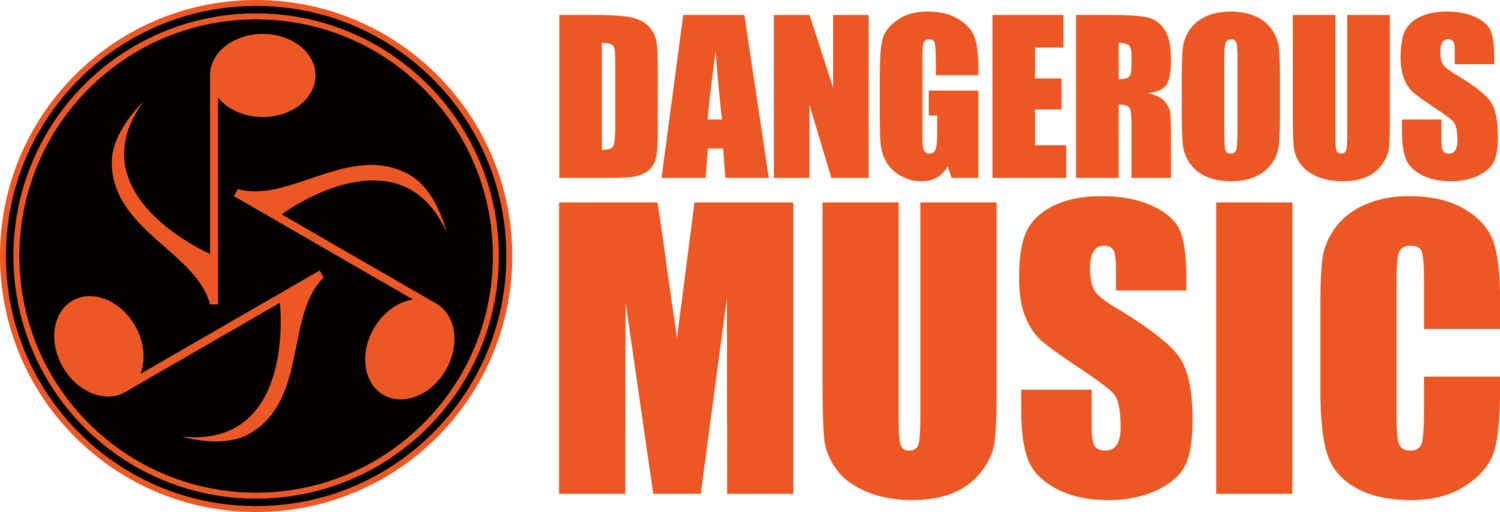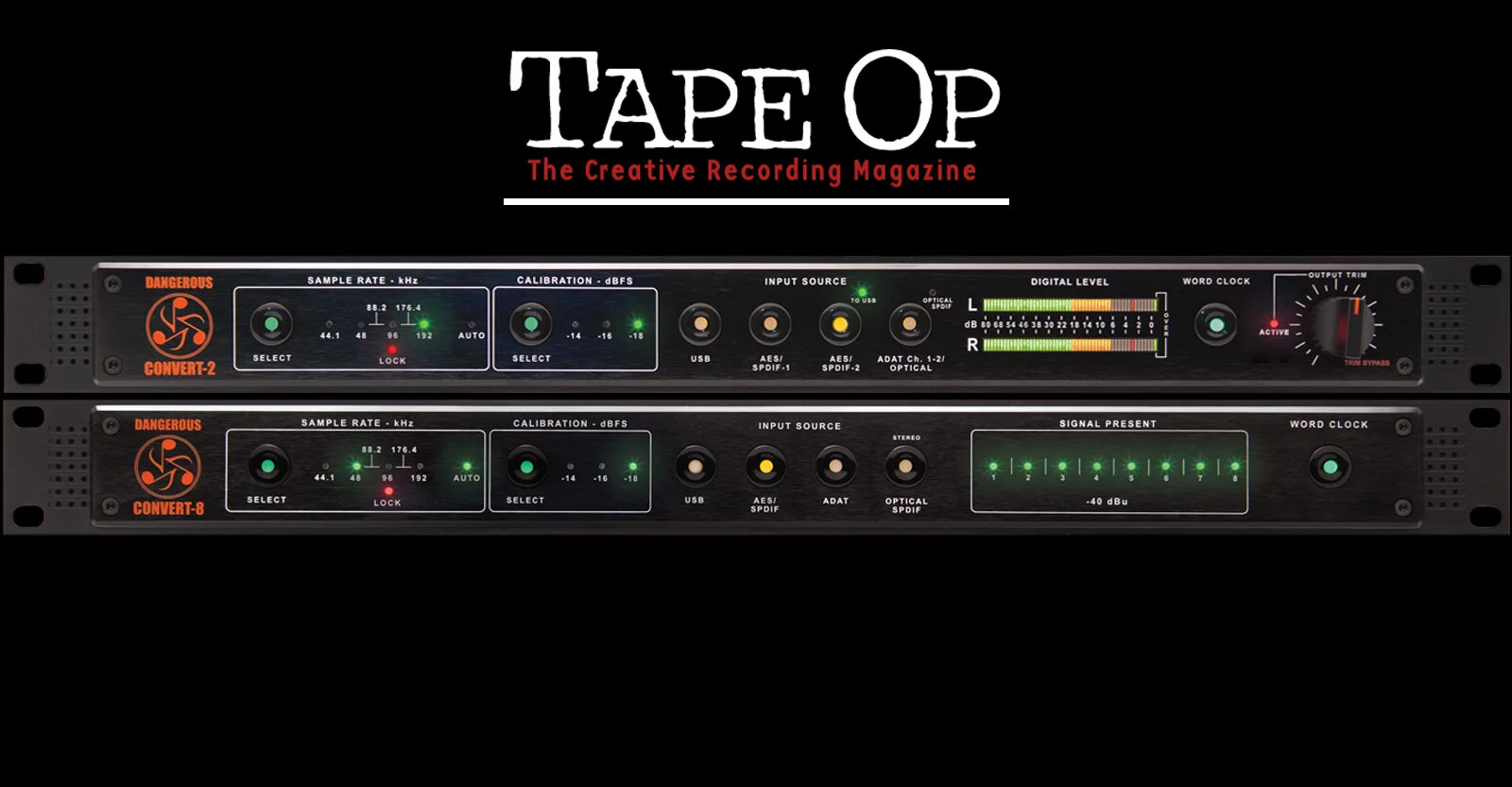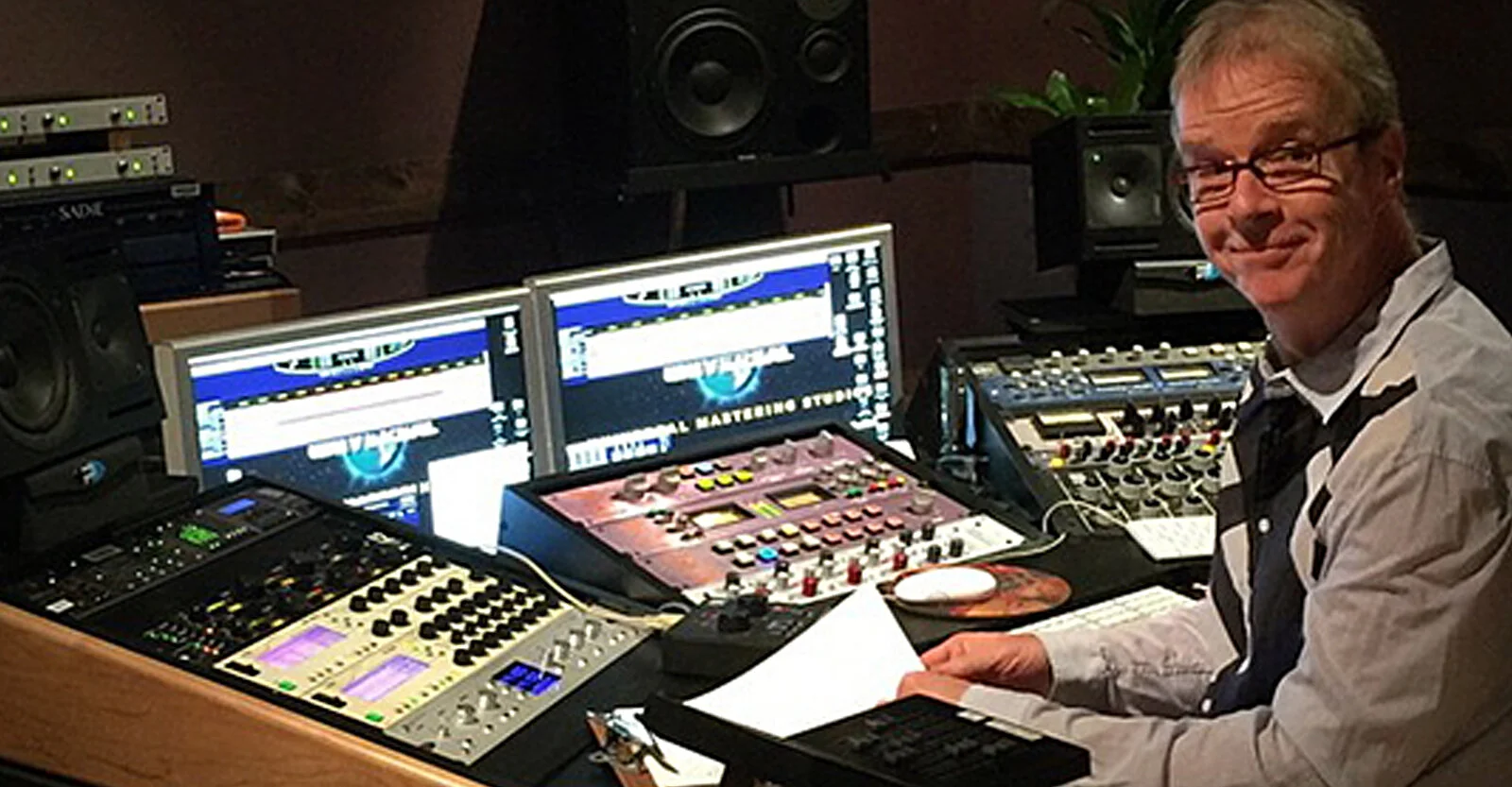TAPEOP REVIEW: CONVERT SERIES
CLICK HERE TO READ THE ORIGINAL ON THE TAPEOP SITE
CONVERT-2 & CONVERT-8 CONVERTERS
by Andy Hong
In a conversation I had a few years ago with Bob Muller, Co-Founder and President of Dangerous Music, Bob alluded to his plans to sell a D/A converter. His company had received a lot of positive feedback in regards to the DACs inside the D-Box, DAC-ST, and Source; and many users of these devices were asking for a standalone DAC. In typical Dangerous fashion, Bob and his colleagues weren’t willing to just pull out the DAC circuitry from one of their existing boxes and call it a day, but instead, they took what they had learned from building these units, and they spent years iterating on a new design, gathering feedback from a number of golden-eared testers along the way. The Dangerous Convert series (pronounced with the emphasis on Con) is the culmination of those efforts. One of the first recipients of production Convertunits was longtime Tape Op contributor Allen Farmelo, who was doing some consulting work for Bob. Allen volunteered to write a review for the magazine; he was very impressed with the stereo Convert-2 and eight-channel Convert-8, as you’ll read in his review below. Allen and I thought it would be fun and informative to gather a few more opinions, so with the help of Bob, we contacted Grammy-winning engineers Chris Athens and Todd Whitelock, who gladly shared their thoughts. Because Chris and Todd had been Convert testers and early adopters, I decided to solicit one more opinion, this time from someone who hadn’t yet heard the new DAC, so I asked Sarah Register from The Mastering Palace to join the party. During her dozen or so years at The Lodge, Sarah mastered thousands of projects, including a few of mine, and I have tremendous trust in her ears. Let’s start this off with Allen first, and then follow with Todd, Chris, and Sarah. -AH
Allen Farmelo: Over the 25 years that I’ve been using digital pro-audio equipment, I’ve really struggled to like it. I don’t hate it, but the sound has always tired me out. And at the risk of sounding like an analog diehard (which I’m not), digital audio always feels just slightly boring to me. So, when there’s a change for the better, no matter how small, I get excited.
The sad truth about digital recording systems, however, is that the best-sounding stuff has been developed by and for audiophiles at astronomical price-points, not for us recordmakers and our real-world budgets. Sit down with a $15,000 high-end stereo DAC, and you get the feeling that so much more is possible on the pro-audio side. Some mastering converters are outstanding, and some DSD conversion approaches true neutrality and realism, but for the most part, multichannel conversion for pro-audio purposes is held back to hit a price-point.
I’m happy to say, however, that Dangerous Music has delivered multichannel digital-to-analog conversion that’s beautiful to listen to and never tires me out. Let me preface my review here by letting you, dear reader, know that I have listened to everything I possibly could over the years, including external clocks, 10M atomic clocks, DSD recorders, re-clocking systems, double-re-clocking systems, esoteric mastering converters, audiophile dream-machines — all hooked up together in countless combinations in an attempt to put together a digital tracking and playback system that was truly satisfying. When I plugged in the Dangerous Music Convert-8, I finally sat back and thought that digital pro-audio might have finally arrived. After hours and hours, and then days — and now weeks — of listening to the same material, it still sounds beautiful.
Transparency is the typical rap about conversion — the assumed goal, really — but after so many years of listening to digital converters, I’ve come to realize that transparency isn’t actually a neutral thing. Even the early ADATs and DATs that I started using over 25 years ago were transparent, though they sounded pretty horrible. And there’s no question that two very transparent modern mastering converters don’t sound the same. As odd as it sounds, transparency actually comes in different colors. This becomes evident when listening to theConvert units, as they are exceptionally transparent, yet they’ve got a very beautiful sound.
Dangerous Music is not the first to make a transparent-yet-beautiful converter. (The Crane Song HEDD 192 and Universal Audio 2192 come to mind as early examples.) But Dangerous has done it better, and I’m going to guess that this has to do with two important aspects of the design. First, the renowned audio fanatic Chris Muth designed the analog path and reconstruction filters. Second, the Dangerous team, along with digital guru Paul Messick, utilized the most up-to-date digital technology with a custom implementation of JetPLL (Jitter Elimination Technology Phase Lock Loop) that forms the core of the Convert’s digital system. You get the feeling that the analog and digital side have really been tweaked over and over to work perfectly together, and those who know the quality of Dangerous gear won’t find that to be a big surprise.
But it’s the sound that matters. Allow me to get rather subjective as I describe what I hear when working with the Converts. Most importantly, I am not annoyed or tired out by these converters, and I just love listening to sounds through them for long stretches. I’m fascinated with three- dimensionality and space in recordings, and with the Converts, I am hearing convincing dimensionality. Sounds become sculptural. The low end is not just “phat” or whatever the latest adjective is — it takes on boulder-like qualities. At slow tempos, I can see what I have come to call “sonic asteroids” in orbit as bass sounds enter the room. The mids are not just “detailed” or “etched” — they’re tactile. It’s as if I’m running my hands over the sounds. Tweaking the mids with my console’s API 550A EQs feels more like working with tangible materials — fabric and stone rather than sound. And the high-end is wide open, not hyped or sizzly, and not toned down either (a trick I’m convinced certain converter designers use to hide harshness). That openness lets the reverbs really do their thing, such that the spaces are as vast as you’d like them to be. Lastly, theConvert is good all the way to 192 kHz, where so many modern converters fall to pieces sonically. I could go on, but I think you get a sense of my subjective experience using the Converts. You’ll have to hear them for yourself to see if they speak to your sensibilities, though I’m guessing they will, because whatever I put into them sounded great coming out.
Other reasons to get excited about the Converts are the feature sets. The stereo Convert-2 has a hard-bypassable potentiometer that lets you hook the unit up directly to a pair of speakers; a front-panel input switch for instant monitoring of multiple digital sources (ADAT, USB, 2 × AES/SPDIF, TOSLINK); instant calibration of levels from a single button (-14, -16, or -18 dBFS); high-resolution meters with clipping indicators that are triggered by three consecutive samples at maximum; digital “Thru” outputs of the AES/SPDIF inputs for feeding other devices; and a “USB Upstream Return” facility to route AES/SPDIF input 2 to the host DAW. The latter two features allow you to simultaneously monitor a digital stream and send it to another destination (like a digital meter) or back to the DAW for recording — or even send a separate stream, like a pre-processed version of the mix, back to the DAW. The Convert-8 forgoes the output trim (for obvious reasons), high-resolution meters, and the USB return; but it holds on to all the other features, including AES/SPDIF Thru outputs and clipping indicators. (It’s worth noting that USB integration is driverless for both Converts on Mac OS. A Windows USB driver for the Convert-2 is available as a download.)
One of the best things I discovered is that DB-25 and ADAT connectors allow you to easily incorporate the Convert-8 into so-called “legacy” systems. You could, for example, buy an old Digidesign 192 Digital I/O and an old HD card, pop the card into a used Mac Pro, and have the best sounding multichannel digital conversion available running on a cheap Pro Tools HD system — for a fraction of the cost of a new PT rig. If you already own an older HD system, or even an older ADAT- equipped Digi 002, 003, or similar, the Convert-8 might be the best way to spend your money right now.
No, the Converts are not cheap, but they’re not ridiculously expensive either. Yes, there are converters out there that will cost a lot less per channel, but as far as I can tell (and I’ve really looked and listened), there are very few stereo units that will sound as good as the Convert-2, and (I will go on record here) no multichannel converters that can top the Convert-8.
Allen Farmelo is at www.butterscotchrecords.net
Todd Whitelock: I was fortunate enough to have heard the Convert-8 in its final R&D phase and was asked by producer Fab Dupont and Dangerous president Bob Muller to do a shootout with it. So I recalled a finished mix that had been done in the same room at Flux Studios using another brand (previously my favorite) DAC, reprinted that, and then swapped in two Convert-8 units. The sound was immediately more vivid, and had a wider and deeper stereo image, with a perceptible space around each instrument. The panning sounded more defined, and everything sat better in the mix; and the track just felt better overall. The low end was pronounced much more, and the separation of kick drum and acoustic bass alone improved so dramatically, that I knew I wanted that sound for a project I had recently recorded — Christian McBride Trio, Live at the Village Vanguard. I asked Bob if the production Convert-8 would be ready by spring, and he said he’d make it happen — and he did.
Going into the project, Christian wanted a sound “realistic” to what the audience would experience, so there would be no mistaking the Vanguard’s iconic acoustics. We recorded two sets every night for a week of the Trio’s performances, so he had a lot of incredible material to choose from. That was the hard part; mixing was the easy part. After cleaning up tom mics and doing some rides on the audience mics, the music really ended up mixing itself, because the Trio’s amazing interplay and dynamics were so naturally balanced.
I knew that I had captured something really special and that I needed to keep it as clean and pure as possible. I knew that the Convert-8 would optimize that minimalistic approach. I also didn’t want to compromise that sound by printing back through any of the ADCs at my disposal, so I thought I could eliminate that stage and go straight to mastering with my laptop and the Convert-8. I forewarned veteran mastering engineer Mark Wilder at Battery Studios that I wasn’t going to be sending him printed mixes, but if he was game, I would instead be bringing a secret DAC weapon to play back the stereo stems I had mixed within Pro Tools HD Native (drums, bass, piano, and audience/ambience) to sum through the Dangerous 2-BUS directly patched into his custom mastering console. It was an elegantly simple process I coined “mixering.” I could make micro-level adjustments directly on the Pro Tools files or faders, as Mark deemed necessary, on individual elements (like piano or bass), which eliminated him having to make a dynamic move or introduce an EQ fix across the whole mix.
Mark, whose ears I trust more than mine, was impressed with the Convert-8. We even clocked his system with it, and in his hyper-accurate listening environment, he confirmed my initial impressions. He agreed that the sound did open up, the stereo field widened, and there was a natural harmonic extension favoring the low end. Mark has mastered three other commercial projects of mine since that game-changing Christian McBride record, and even though I may have printed stereo mixes back at the studio (because the mixing was more involved or had more elements), I still took my laptop and played all my masters through the Convert-8 to get “that sound.” We still A/B’ed (because we are compelled to) and compared those playbacks with the same prints he had pre- loaded into his computer. We both always leaned into the Convert-8, agreeing that it improved the “feel” of my mixes and ultimately enhanced the listening experience, and so we always went with it. The Convert-8 has been a revelation. I guess it’s not my secret weapon anymore.
Todd Whitelock is at todd@whitelockaudio.com
Chris Athens: The Convert-2 is typical Dangerous Music — built like a tank, innovative in design, and incredible in sound. The buttons are solid, are well laid out, and have a positive feel. There are no fiddly menus to scroll through. (Scrolling through LCD menus sucks!) Plus, the meters are excellent and give great visual feedback.
The thoughtfully included USB Upstream Return feature allows for easy print-back of mixes/masters to your DAW, and the excellent custom pot for output trim allows you to drive a pair of powered speakers directly from the Convert-2. An internal relay bypasses the trim pot if you want to feed straight line-level to other gear, like the Dangerous Monitor ST that I use to control my speakers.
The real clincher here is the sound — brilliant, rock solid, and detailed. Better than many converters that are much more expensive. Throw in a great master clock, and you start to see how the Convert-2 is a “must audition” if you’re looking to upgrade your conversion. I don’t need a new converter, but I’m damn sure gonna buy this one. Economy, utility, innovation, and excellence. Designed and built by professional engineers for professional engineers. Like I said, the Convert-2 is typical Dangerous Music.
Chris Athens is at www.chrisathensmasters.com
Sarah Register: The Convert-2 really excels on material that makes use of a wide stereo image; it translates spatial depth and breadth with aplomb. Not surprisingly, the Convert-2 exhibits a little less center than some of the other converters at my disposal, though it still creates a commanding presentation. It fosters a listening environment for comfortable long-term playback; it’s neither pushy nor insistent, but importantly, it doesn’t downplay any frequency ranges.
To get nitty-gritty, I picked out something I know very well, and in particular, a track that sounds broad, deep, and not too crowded — Faux Fix’s “Addition By Subtraction” (produced by Nathan Johnson and mixed by John Sinclair), which I’d mastered earlier in the year. I was already in love with the musicality and the presentation Faux Fix created. Upon repeated listens of the song through the Convert-2, I felt that an even larger and more glorious stage was being set for the inherent beauty of the music, and individual instruments and sounds were given more of their own dimension. To me, that’s what the Convert-2 does best: It makes wide, beautiful things even more beautiful.
Sarah Register is at www.themasteringpalace.com
While editing this multi-perspective review, I realized that I needed to hear the Convert DAC with my own ears. When UPS dropped off the Convert-2, I was expecting it to be the heaviest piece of gear in the world, given all the praise I had just finished assembling from such well-respected engineers. Thankfully, it wasn’t any heavier than what you’d expect from a 1RU-height Dangerous box full of quality engineering and parts. I plugged it into one of the digital outputs of my Sony DMX-R100 console [Tape Op #25] and then fed my ADAM Audio S3-A monitors [#33] directly from the Convert-2. Wow! The sonic improvement was immediate. I played back some of own mixes and listened to songs from a few of my favorite albums (at 44.1 kHz and at 24-bit, 96 kHz), and I agree with most everything everyone else said above. In particular, Allen and Sarah’s comments on dimensionality and width, and Todd’s on separation really rang true; through the Convert-2, instruments, sounds, and textures became more palpable in the mix. Bob explained it to me this way: “The strong imaging doesn’t come from some magic ‘width circuit’ in there. All it is, is really good channel separation, particularly on the analog side, and an extremely low jitter clock. No magic — just not being satisfied until we squeezed every last bit of performance into the design.” Which reminds me of the first time I saw magicians Penn & Teller break the tenets of their profession. They purposefully uncovered one of their magic tricks by removing the distractions and revealing the truth behind the illusion — in a sense, taking the blinders off the audience. I feel like the Dangerous Music Convert is doing the same thing.



